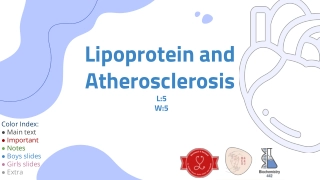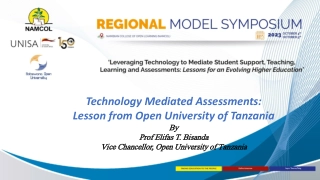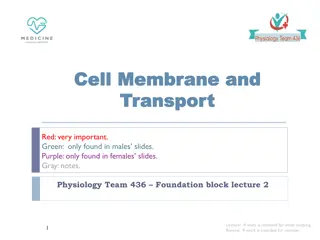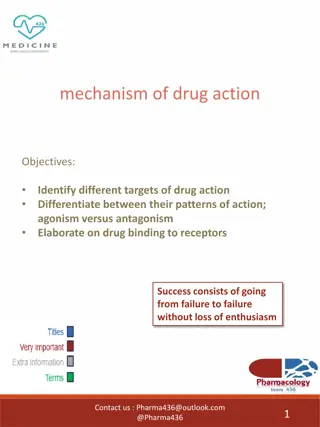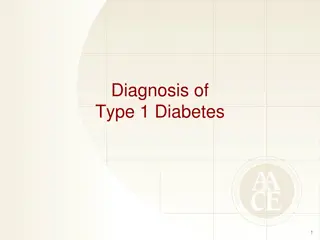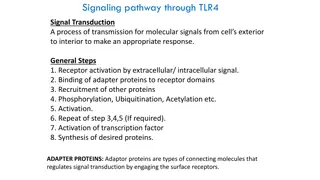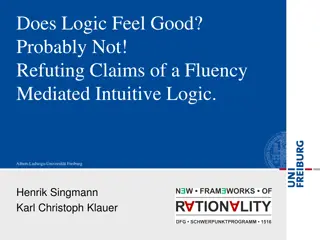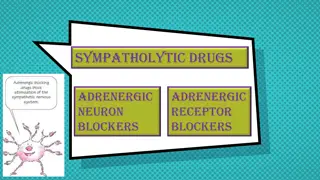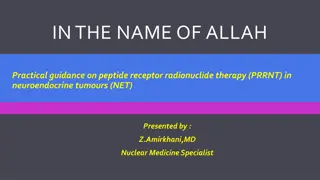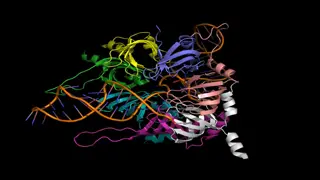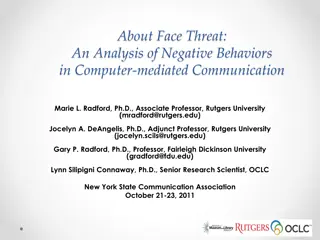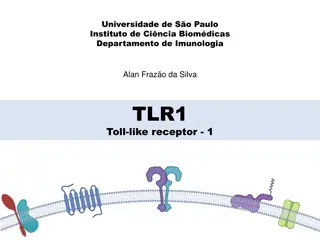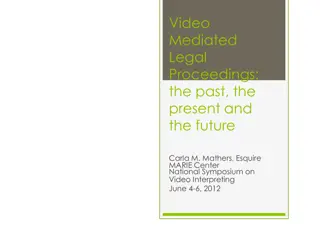Lipoprotein and Atherosclerosis
Understand the correlation between lipoprotein metabolism imbalance and the development of atherosclerosis. Learn about LDL and HDL cholesterol metabolism, receptor-mediated endocytosis, and the role of lipoprotein(a).
1 views • 19 slides
Technology Mediated Assessments
Discover how the Open University of Tanzania revolutionized traditional assessments using technology, reducing costs, enhancing security, and increasing efficiency. From the implementation of technology-mediated assessments to the secure management of exam processes, explore their innovative approac
0 views • 32 slides
Immune-deficiencies
Immune deficiencies can be classified into primary hereditary disorders based on clinical presentations, including cell-mediated, antibody-mediated, non-specific, and complement activation deficiencies. Major clinical manifestations of immune disorders range from B-cell deficiencies to phagocytic ce
2 views • 46 slides
Exploring Learning Theories and Nudging Theory in Educational Technology
Today's session at the University of Washington delves into popular learning theories influencing educational technology development, implementation, and evaluation. Dr. Taylor's work focuses on digitally mediated intergenerational learning, while the Educational Software Development Cycle underscor
7 views • 20 slides
Understanding E-Business: Key Concepts and Development
E-Business, a computer-mediated process conducted by various organizations, encompasses a range of business activities facilitated through the internet. It differs from e-commerce by not only focusing on online transactions but also on internal business processes. The development of e-business is dr
3 views • 15 slides
Understanding Barbiturates: History, Types, and Mechanism of Action
Barbiturates are derivatives of barbituric acid, acting as depressants on the central nervous system by potentiating GABA. First synthesized in 1864, they have a rich history in medicine. Types include Amobarbital, Phenobarbital, and Pentobarbital. The synthesis of barbituric acid involves a condens
0 views • 28 slides
E-Business
E-Business, or electronic business, encompasses computer-mediated processes in organizations, including for-profit, governmental, or nonprofit entities. It involves a range of business activities conducted over networks, focusing on production, customer service, and internal management processes. E-
0 views • 25 slides
GLP-1 Receptor Agonists in HIV: Addressing Weight Gain Challenges
GLP-1 receptor agonists offer a promising therapeutic approach for weight management in individuals with HIV. Weight gain is a common issue, exacerbated by antiretroviral therapy, and can lead to metabolic risks. This presentation by Dr. Suman Srinivasa discusses the potential of GLP-1 receptor agon
2 views • 32 slides
Understanding Active Transport: Energy-Driven Cellular Processes
Active transport is a vital process in cells that require energy in the form of ATP to move materials across the plasma membrane against their concentration gradient. This process involves pumps, endocytosis, and exocytosis. The sodium-potassium pump in nerve cells is a classic example of active tra
0 views • 9 slides
Understanding Cell Membrane Transport: Diffusion and Facilitated Diffusion
Cell membrane transport plays a crucial role in maintaining cellular functions by regulating the movement of substances across the membrane. Diffusion, a passive transport process, allows molecules to move from areas of high concentration to low concentration without energy expenditure. Within diffu
2 views • 20 slides
Understanding Cell Membrane Structure and Function
This educational content delves into the structure and function of the cell membrane, covering topics such as the fluid mosaic model, permeability, carrier-mediated processes, and membrane proteins. It explains the composition of the cell membrane, selective permeability, and the roles of integral a
0 views • 36 slides
Understanding Drug Action Mechanisms and Receptor Targets
Pharmacodynamics involves studying the effects of drugs on biochemical and physiological levels, focusing on drug actions through receptor-mediated and non-receptor mechanisms. The interaction between drugs and targets like proteins and enzymes impacts cellular functions. Different binding forces, s
0 views • 9 slides
Understanding Antibody-Mediated Immunity in Humoral Immunity
This content delves into the mechanisms of antibody-mediated immunity, focusing on B-cells as key players in humoral immunity. It covers topics such as activation of B-cells, clonal selection, generation of plasma and memory cells, primary and secondary immune responses, and the structure and functi
0 views • 20 slides
Classification and Genetic Defects of Diabetes
The diagnosis and differential diagnosis of Type 1 and Type 2 diabetes are discussed, detailing the clinical courses, age of onset, body weight characteristics, onset patterns, and genetic factors. The etiologic classification of diabetes including insulin-deficient, immune-mediated, monogenic, and
0 views • 16 slides
Understanding Food Allergies in Children
Food allergies in children can be IgE-mediated or non-IgE-mediated reactions, with common allergens including fish, eggs, peanuts, and more. The prevalence of food allergies in Europe and North America ranges from 6% to 8% in children up to 3 years old. Symptoms may vary from immediate reactions lik
0 views • 11 slides
Understanding Newborn Screening and T-Cell Receptor Excision Circles
The content discusses the importance of newborn screening, characteristics of disorders, T-cell receptor excision circles (TRECs), and the identification of severe conditions like SCID through TREC assay. It highlights the significance of early detection and treatment, emphasizing the value of high-
0 views • 7 slides
Understanding Hypersensitivity Reactions in Immunology
Hypersensitivity in immunology refers to an altered immune response against antigens, leading to hyperreactivity and immunopathology. This article delves into the different categories of adaptive hypersensitivities, focusing on Immediate (Type I), Antibody-Mediated Cytotoxic (Type II), and Immune Co
0 views • 6 slides
Understanding Quantitative Aspects of Drug Action
Explore the quantitative aspects of drug action, including drug receptor binding, concentration binding curves, dose-response curves, and types of antagonism. Learn to relate drug concentration to receptor binding capacity and response produced. Discover how concentration binding curves and dose-res
0 views • 29 slides
Draft E-Commerce Policy Framework of Pakistan Presentation
The draft E-Commerce Policy Framework of Pakistan, presented by the Ministry of Commerce & Textile Commerce Division, defines e-commerce as the buying and selling of goods or services, including digital products, through electronic transactions conducted via the internet or other computer-mediated n
0 views • 26 slides
Understanding Hypersensitivity Reactions and Classification
Hypersensitivity reactions occur in sensitized hosts following contact with specific antigens, leading to injurious consequences. The Gell and Coombs Classification categorizes reactions into Type I, II, III, and IV based on immune response and duration. Type I reactions are immediate and humoral, w
0 views • 30 slides
Immune Responses to Parasitic Infections and Evasive Strategies by Protozoan and Helminth Parasites
Parasitic infections pose complex challenges to the immune system due to the diverse nature of parasites, including protozoans and helminths. Protozoan parasites move between arthropod vectors and mammalian hosts, requiring both humoral and cell-mediated immune responses. Meanwhile, helminths, as mu
0 views • 15 slides
The Transition from Rural Community to Urban Mass Society: Impact of Media Technologies
Our lives are influenced by the saturation of media technologies and images, leading to questions on American culture and politics. The shift from rural community to urban mass society has resulted in individuals being isolated and disconnected from traditions and values, shaping their hearts and mi
0 views • 16 slides
Managing Radiation Accidents: Challenges and Strategies
Radiation accidents present significant challenges in terms of managing exposure and mitigating consequences. International organizations like the IAEA and WHO provide guidelines for handling such incidents. Possible scenarios include dispersal of radioactive substances in various contexts, such as
0 views • 35 slides
Signaling Pathway Through TLR4: A Molecular Signal Transduction Process
Signaling through Toll-like Receptor 4 (TLR4) involves a series of steps starting from receptor activation to transcription factor activation, leading to the synthesis of desired proteins. The pathway can occur through MyD88-dependent or TRIF-dependent pathways, resulting in different downstream eff
0 views • 5 slides
Understanding Deductive Reasoning and Intuitive Logic
Deductive reasoning involves assessing the validity of arguments based on premises, while fluency-mediated intuitive logic suggests people have an intuitive sense of logicality. Challenges arise in drawing correct conclusions from abstract syllogisms, indicating a need for deliberate and effortful p
0 views • 24 slides
Understanding Adrenergic Neuron Blockers: Mechanisms and Pharmacological Effects
Explore the mechanisms of action of adrenergic neuron blockers and classify adrenergic receptor blockers into selective and non-selective categories. Delve into the pharmacokinetic aspects and pharmacodynamic effects of these blockers, such as false transmitter formation, store depletion, release in
0 views • 29 slides
Digital Evolution in Photojournalism: New Technologies and Storytelling Transformation
The advent of new digital media technologies has revolutionized the traditional methods of storytelling in photojournalism. This evolution has enabled more interactive and engaging narratives, impacting user engagement and response to visual stories. Platforms like Humans of New York exemplify the m
0 views • 18 slides
Importance of Employer Engagement in Education for Young Adults' Career Development
Young adults' perceptions of workplace exposure through school-mediated programs play a crucial role in their transition to the labor market. This text discusses the significance of employer engagement in education, emphasizing the benefits of work experience, career guidance, and school-age employe
0 views • 29 slides
Understanding Cellular Transport and Cell Membrane Function
Explore the structure and function of cells, tissues, organs, and organ systems as students delve into how cells take in nutrients, grow, and divide. Discover the organization of cells into tissues, organs, and systems, and learn about the crucial role of cell membranes in maintaining homeostasis th
0 views • 34 slides
Understanding Apitherapy in Immune-Mediated Disorders
Apitherapy, the medical use of honeybee products, holds a rich history dating back to ancient civilizations like Egypt and Greece. It encompasses various bee-derived substances such as bee venom, honey, royal jelly, propolis, and beeswax, offering a holistic approach to healing immune-mediated disor
0 views • 84 slides
Comprehensive Guide to Peptide Receptor Radionuclide Therapy (PRRNT) in Neuroendocrine Tumours (NET)
Peptide Receptor Radionuclide Therapy (PRRNT) is a targeted approach using radiopharmaceuticals to deliver radiation to neuroendocrine tumors expressing specific receptors. This therapy, involving 90Y-DOTATOC or 177Lu-DOTATATE, has shown promising results in treating NETs with minimal side effects.
0 views • 36 slides
Understanding Splice Sites and Splicing Elements in the Inhibitory Dopamine Receptor Gene (D2)
In this project, the focus is on identifying splice sites relevant to the inhibitory dopamine receptor gene (D2). The problem involves finding splicing elements within a specific range of known splice sites in the gene. The data provided includes the D2 gene entry in FASTA format, a database of spli
0 views • 13 slides
Analysis of Negative Behaviors in Computer-mediated Communication
This analysis delves into negative behaviors in computer-mediated communication, exploring threats to face value and interactions in virtual reference encounters. It discusses the concept of face-work, the importance of maintaining positive social value, and the impact of face threats on individuals
0 views • 14 slides
Cardiovascular Outcomes Trials with GLP-1 Receptor Agonists
GLP-1 receptor agonists are newer non-insulin-based glucose-lowering therapies with demonstrated cardiovascular benefits. This educational module covers completed CVOTs involving GLP-1 receptor agonists, treatment options for type 2 diabetes, study designs, results, and a timeline of new treatment o
0 views • 47 slides
Investigating the Impact of Weekly Incretin on Cardiovascular Events in Diabetes
Individuals with type 2 diabetes have an increased risk of cardiovascular events compared to those without the condition. Research indicates that certain GLP-1 receptor agonists have shown promising results in reducing cardiovascular events in diabetic patients with specific HbA1c levels. However, t
0 views • 69 slides
Nuclear Receptor-Mediated Toxicity: Molecular Insights and Implications
TOXICOLOGY research on Nuclear Receptor-Mediated Toxicity by Prof. Zdeněk Dvořák delves into the evidence, molecular properties, structures, and signaling pathways of nuclear receptors such as Aryl Hydrocarbon Receptor (AhR). Detailed information on the impact of AhR-mediated toxicity, including
0 views • 19 slides
TLR1 - Toll-like Receptor-1 in Immunology Research at University of São Paulo
Alan Frazão da Silva from the Department of Immunology at the University of São Paulo's Institute of Biomedical Sciences is conducting research on TLR1, a Toll-like receptor involved in immune responses against gram-negative bacteria and autoimmune diseases like Type 1 Diabetes and Graves' disease
0 views • 5 slides
Evolution of Video-Mediated Legal Proceedings
Exploring the evolution of video-mediated legal proceedings, this content delves into past, present, and future scenarios. It discusses the challenges of language barriers, the balance between efficiency and effectiveness, and the use of remote interpreting in different legal contexts. From the slow
0 views • 27 slides
Comprehensive Guide to Ketamine Use in Palliative Medicine: Indications, Effects, and Dosage
Ketamine, a Schedule 2 controlled substance, is utilized as a third-line analgesic for managing complex pain conditions. Acting as an N-methyl-D-aspartate (NMDA) receptor inhibitor, it exerts analgesic effects by antagonizing the NMDA receptor, impacting neuronal hyperexcitability and reducing opioi
0 views • 17 slides
Advances in Nonequilibrium Green's Function Method for Energy Transfer Mediated by Photons
Research discusses the application of the Nonequilibrium Green's Function method for analyzing energy, momentum, and angular momentum transfers mediated by photons. Various topics covered include near-field heat transfer, Coulomb interactions, electron-photon transitions, local equilibrium assumptio
0 views • 37 slides
